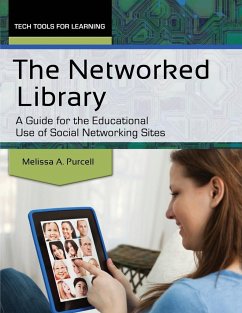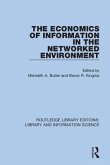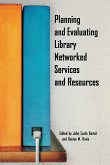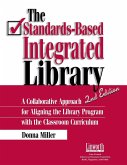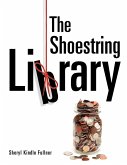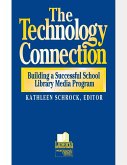- Broschiertes Buch
- Merkliste
- Auf die Merkliste
- Bewerten Bewerten
- Teilen
- Produkt teilen
- Produkterinnerung
- Produkterinnerung
The lesson plans in this book enable educators to easily incorporate networking technologies into the classroom-not just a fun enrichment activity, but one that is selective and intentional to teach the required standards. Our Web 2.0 world is based on participation. Incorporating networking sites into classroom lesson plans invites students to participate and get involved using the digital learning styles with which they are already accustomed-interacting with new information, building knowledge, and sharing that knowledge with an authentic, responsive audience. The Networked Library: A Guide…mehr
Andere Kunden interessierten sich auch für
![The Economics of Information in the Networked Environment The Economics of Information in the Networked Environment]() The Economics of Information in the Networked Environment50,99 €
The Economics of Information in the Networked Environment50,99 €![Planning and Evaluating Library Networked Services and Resources Planning and Evaluating Library Networked Services and Resources]() Planning and Evaluating Library Networked Services and Resources61,99 €
Planning and Evaluating Library Networked Services and Resources61,99 €![The Standards-Based Integrated Library The Standards-Based Integrated Library]() Donna P. MillerThe Standards-Based Integrated Library47,99 €
Donna P. MillerThe Standards-Based Integrated Library47,99 €![Research-based Reading Strategies in the Library for Adolescent Learners Research-based Reading Strategies in the Library for Adolescent Learners]() Carianne BernadowskiResearch-based Reading Strategies in the Library for Adolescent Learners48,99 €
Carianne BernadowskiResearch-based Reading Strategies in the Library for Adolescent Learners48,99 €![The Library Media Specialist In the Writing Process The Library Media Specialist In the Writing Process]() Marge CoxThe Library Media Specialist In the Writing Process47,99 €
Marge CoxThe Library Media Specialist In the Writing Process47,99 €![The Shoestring Library The Shoestring Library]() Sheryl Kindle FullnerThe Shoestring Library47,99 €
Sheryl Kindle FullnerThe Shoestring Library47,99 €![The Technology Connection The Technology Connection]() The Technology Connection47,99 €
The Technology Connection47,99 €-
-
-
The lesson plans in this book enable educators to easily incorporate networking technologies into the classroom-not just a fun enrichment activity, but one that is selective and intentional to teach the required standards. Our Web 2.0 world is based on participation. Incorporating networking sites into classroom lesson plans invites students to participate and get involved using the digital learning styles with which they are already accustomed-interacting with new information, building knowledge, and sharing that knowledge with an authentic, responsive audience. The Networked Library: A Guide for the Educational Use of Social Networking Sites demonstrates how integrating networking tools that students enjoy using can improve their learning in the classroom. The book is designed to take educators who are new to networking sites from the ground up, while allowing experts to jump directly into the lesson plan chapters. It covers many types of networking sites that educators can use to their advantage: media sharing sites, including YouTube, TeacherTube, Wikimedia Commons, and Flickr; microblogs and wikis such as Wikispaces, PBworks, and Twitter; and social networking sites including Facebook, Ning, and Edmodo.
Hinweis: Dieser Artikel kann nur an eine deutsche Lieferadresse ausgeliefert werden.
Hinweis: Dieser Artikel kann nur an eine deutsche Lieferadresse ausgeliefert werden.
Produktdetails
- Produktdetails
- Verlag: Linworth
- Seitenzahl: 186
- Erscheinungstermin: 16. Juli 2012
- Englisch
- Abmessung: 280mm x 216mm x 10mm
- Gewicht: 484g
- ISBN-13: 9781586835453
- ISBN-10: 1586835459
- Artikelnr.: 34671672
- Herstellerkennzeichnung
- Libri GmbH
- Europaallee 1
- 36244 Bad Hersfeld
- gpsr@libri.de
- Verlag: Linworth
- Seitenzahl: 186
- Erscheinungstermin: 16. Juli 2012
- Englisch
- Abmessung: 280mm x 216mm x 10mm
- Gewicht: 484g
- ISBN-13: 9781586835453
- ISBN-10: 1586835459
- Artikelnr.: 34671672
- Herstellerkennzeichnung
- Libri GmbH
- Europaallee 1
- 36244 Bad Hersfeld
- gpsr@libri.de
Melissa A. Purcell, PhD, is the media specialist at Glynn Academy, Brunswick, GA, and is part-time professor in the Instructional Technology department at Georgia Southern University.
Acknowledgments
Introduction
Who Should Use This Book
Author Blog
Blog Content
Chapter Structure
Book Structure
Chapter Categories
Move through the Stages
Standards Provide a Learning Objective and Common Language
Common Core State Standards and the Librarian
Common Core State Standards in This Book
Information and Technology Literacy Standards
International Society for Technology in Education National Education
Technology Standards for Students
The Name Game
Chapter 1: What Are Networking Sites and Why Use Them?
What Is Educational Networking?
Networking Sites-Love Them or Hate Them
Benefits of Using Networking Sites in Education
Terms to Know
Networking Sites to Know
Why Use Educational Networking in Your Classroom?
Be a Media Master
Suggestions for Content to Post
Advice for Management
Chapter 2: Guidelines to Keep Your Students and Yourself Safe When
Integrating Networking Sites in the Classroom
What Are the Issues with Using Networking Sites?
Terms to Know
Fear of Cyberspace
Bullying in Cyberspace
A Digital Footprint
Plagiarism, Copyright Laws, Fair Use, and Creative Commons
What Do the Laws Require Teachers to Do?
Fight the Filter
Policies
Guidelines for Student Use of Networking Sites
General Guidelines to Follow When Online
Ways to Avoid Risks Involved with Using Networking Sites
Additional Resources Worth Checking Out
Chapter 3: Media Sharing Sites in the Classroom
Why Use Media Sharing Sites?
Media Sharing Site Lesson Plans
Stage One: Promotional Book Poster Lesson Plan
Terms to Know
Networking Sites to Know
Other Websites Used in the Lessons
Stage Two: Glogster Edu Promotional Book Poster Lesson Plan
Stage Three: Glogster Promotional Book Poster Lesson Plan
Lesson Plans Adapted for Other Subjects
Stage One: Book Review Storyboard/Script Lesson Plan
Stage Two: Thirty-Second Book Trailer Lesson Plan
Stage Three: Two-Minute Book Trailer Lesson Plan
Suggestions for Videos You Can Create and Post to a Media Sharing Website,
Such as a YouTube Channel
Additional Resources Worth Checking Out
Lesson Plans Adapted for Other Subjects
Chapter 4: Microblogs and Wikis in the Classroom
Why Use Microblogging and Wiki Sites?
Terms to Know
Microblogging and Wiki Lesson Plans
Stage One: Book Summary on Paper Lesson Plan
Networking Sites to Know
Other Websites Used in the Lessons
Stage Two: Book Summary Lesson Plan
Stage Three: Book Summary on Twitter Lesson Plan
Lesson Plans Adapted for Other Subjects
Have Student Complete a KWL (What I Know/What I Want to Know/What I
Learned) Chart on Twitter
Twitter Hashtags
Twitter Resources
Stage One: Wiki-Style Book Review Poster Lesson Plan
Stage Two: Book Review on a Secure Wiki Lesson Plan
Stage Three: Podcast Book Review on a Public Wiki Lesson Plan
Lesson Plans Adapted for Other Subjects
Additional Resources Worth Checking Out
Chapter 5: Social Networking Sites in the Classroom
Why Use Social Sites?
Terms to Know
Social Networking Sites Lesson Plans
Stage One: Book Summary Character Profile on Paper Lesson Plan
Networking Sites to Know
Other Websites Used in the Lessons
Stage Two: Book Summary Character Profile Lesson Plan
Stage Three: Book Summary on Facebook Lesson Plan
Lesson Plans Adapted for Other Subjects
Stage One: Profile Page on Paper Lesson Plan
Stage Two: Profile Page Lesson Plan
Stage Three: Facebook Profile Page Lesson Plan
Additional Resources Worth Checking Out
Lesson Plans Adapted for Other Subjects
Chapter 6: A Few Final Words
Where We Are Now
Where to Next
Networking Sites Used for Professional Development
Educators Worth Checking Out
References
Appendix
Chapter 3 Handouts
Instructions for Setting up a YouTube Account and Uploading Videos
Instructions to Customize Your YouTube Channel
Instructions for Setting Up a Glogster Edu Account
Instructions for Student Glogster Edu Account Setup
Instructions for Setting Up an Animoto Education Account
Instructions for Creating a Video in Animoto
Instructions for Setting Up a One True Media Account
Instructions for Creating a Video Using One True Media
Instructions for Creating a Video Using JayCut
Instructions for Searching for Creative Commons Licensed Videos, Images,
and Audio
Chapter 4 Handouts
Instructions Letter for Patrons to Set Up a Twitter Account
Instructions for Creating a Word Cloud Using Wordle
Instructions for Creating a Word Cloud Using Tagxedo
Instructions for Setting Up a PBworks Account
Instructions for Setting Up a Wikispaces Account
Instructions for Creating a Podcast Using Vocaroo
Instructions for Creating a Voki and Embedding on a Wiki
Chapter 5 Handouts
Instructions Letter for Patrons to Set Up a Facebook Account
Instructions for Setting Up an Edmodo Account
Index
Introduction
Who Should Use This Book
Author Blog
Blog Content
Chapter Structure
Book Structure
Chapter Categories
Move through the Stages
Standards Provide a Learning Objective and Common Language
Common Core State Standards and the Librarian
Common Core State Standards in This Book
Information and Technology Literacy Standards
International Society for Technology in Education National Education
Technology Standards for Students
The Name Game
Chapter 1: What Are Networking Sites and Why Use Them?
What Is Educational Networking?
Networking Sites-Love Them or Hate Them
Benefits of Using Networking Sites in Education
Terms to Know
Networking Sites to Know
Why Use Educational Networking in Your Classroom?
Be a Media Master
Suggestions for Content to Post
Advice for Management
Chapter 2: Guidelines to Keep Your Students and Yourself Safe When
Integrating Networking Sites in the Classroom
What Are the Issues with Using Networking Sites?
Terms to Know
Fear of Cyberspace
Bullying in Cyberspace
A Digital Footprint
Plagiarism, Copyright Laws, Fair Use, and Creative Commons
What Do the Laws Require Teachers to Do?
Fight the Filter
Policies
Guidelines for Student Use of Networking Sites
General Guidelines to Follow When Online
Ways to Avoid Risks Involved with Using Networking Sites
Additional Resources Worth Checking Out
Chapter 3: Media Sharing Sites in the Classroom
Why Use Media Sharing Sites?
Media Sharing Site Lesson Plans
Stage One: Promotional Book Poster Lesson Plan
Terms to Know
Networking Sites to Know
Other Websites Used in the Lessons
Stage Two: Glogster Edu Promotional Book Poster Lesson Plan
Stage Three: Glogster Promotional Book Poster Lesson Plan
Lesson Plans Adapted for Other Subjects
Stage One: Book Review Storyboard/Script Lesson Plan
Stage Two: Thirty-Second Book Trailer Lesson Plan
Stage Three: Two-Minute Book Trailer Lesson Plan
Suggestions for Videos You Can Create and Post to a Media Sharing Website,
Such as a YouTube Channel
Additional Resources Worth Checking Out
Lesson Plans Adapted for Other Subjects
Chapter 4: Microblogs and Wikis in the Classroom
Why Use Microblogging and Wiki Sites?
Terms to Know
Microblogging and Wiki Lesson Plans
Stage One: Book Summary on Paper Lesson Plan
Networking Sites to Know
Other Websites Used in the Lessons
Stage Two: Book Summary Lesson Plan
Stage Three: Book Summary on Twitter Lesson Plan
Lesson Plans Adapted for Other Subjects
Have Student Complete a KWL (What I Know/What I Want to Know/What I
Learned) Chart on Twitter
Twitter Hashtags
Twitter Resources
Stage One: Wiki-Style Book Review Poster Lesson Plan
Stage Two: Book Review on a Secure Wiki Lesson Plan
Stage Three: Podcast Book Review on a Public Wiki Lesson Plan
Lesson Plans Adapted for Other Subjects
Additional Resources Worth Checking Out
Chapter 5: Social Networking Sites in the Classroom
Why Use Social Sites?
Terms to Know
Social Networking Sites Lesson Plans
Stage One: Book Summary Character Profile on Paper Lesson Plan
Networking Sites to Know
Other Websites Used in the Lessons
Stage Two: Book Summary Character Profile Lesson Plan
Stage Three: Book Summary on Facebook Lesson Plan
Lesson Plans Adapted for Other Subjects
Stage One: Profile Page on Paper Lesson Plan
Stage Two: Profile Page Lesson Plan
Stage Three: Facebook Profile Page Lesson Plan
Additional Resources Worth Checking Out
Lesson Plans Adapted for Other Subjects
Chapter 6: A Few Final Words
Where We Are Now
Where to Next
Networking Sites Used for Professional Development
Educators Worth Checking Out
References
Appendix
Chapter 3 Handouts
Instructions for Setting up a YouTube Account and Uploading Videos
Instructions to Customize Your YouTube Channel
Instructions for Setting Up a Glogster Edu Account
Instructions for Student Glogster Edu Account Setup
Instructions for Setting Up an Animoto Education Account
Instructions for Creating a Video in Animoto
Instructions for Setting Up a One True Media Account
Instructions for Creating a Video Using One True Media
Instructions for Creating a Video Using JayCut
Instructions for Searching for Creative Commons Licensed Videos, Images,
and Audio
Chapter 4 Handouts
Instructions Letter for Patrons to Set Up a Twitter Account
Instructions for Creating a Word Cloud Using Wordle
Instructions for Creating a Word Cloud Using Tagxedo
Instructions for Setting Up a PBworks Account
Instructions for Setting Up a Wikispaces Account
Instructions for Creating a Podcast Using Vocaroo
Instructions for Creating a Voki and Embedding on a Wiki
Chapter 5 Handouts
Instructions Letter for Patrons to Set Up a Facebook Account
Instructions for Setting Up an Edmodo Account
Index
Acknowledgments
Introduction
Who Should Use This Book
Author Blog
Blog Content
Chapter Structure
Book Structure
Chapter Categories
Move through the Stages
Standards Provide a Learning Objective and Common Language
Common Core State Standards and the Librarian
Common Core State Standards in This Book
Information and Technology Literacy Standards
International Society for Technology in Education National Education
Technology Standards for Students
The Name Game
Chapter 1: What Are Networking Sites and Why Use Them?
What Is Educational Networking?
Networking Sites-Love Them or Hate Them
Benefits of Using Networking Sites in Education
Terms to Know
Networking Sites to Know
Why Use Educational Networking in Your Classroom?
Be a Media Master
Suggestions for Content to Post
Advice for Management
Chapter 2: Guidelines to Keep Your Students and Yourself Safe When
Integrating Networking Sites in the Classroom
What Are the Issues with Using Networking Sites?
Terms to Know
Fear of Cyberspace
Bullying in Cyberspace
A Digital Footprint
Plagiarism, Copyright Laws, Fair Use, and Creative Commons
What Do the Laws Require Teachers to Do?
Fight the Filter
Policies
Guidelines for Student Use of Networking Sites
General Guidelines to Follow When Online
Ways to Avoid Risks Involved with Using Networking Sites
Additional Resources Worth Checking Out
Chapter 3: Media Sharing Sites in the Classroom
Why Use Media Sharing Sites?
Media Sharing Site Lesson Plans
Stage One: Promotional Book Poster Lesson Plan
Terms to Know
Networking Sites to Know
Other Websites Used in the Lessons
Stage Two: Glogster Edu Promotional Book Poster Lesson Plan
Stage Three: Glogster Promotional Book Poster Lesson Plan
Lesson Plans Adapted for Other Subjects
Stage One: Book Review Storyboard/Script Lesson Plan
Stage Two: Thirty-Second Book Trailer Lesson Plan
Stage Three: Two-Minute Book Trailer Lesson Plan
Suggestions for Videos You Can Create and Post to a Media Sharing Website,
Such as a YouTube Channel
Additional Resources Worth Checking Out
Lesson Plans Adapted for Other Subjects
Chapter 4: Microblogs and Wikis in the Classroom
Why Use Microblogging and Wiki Sites?
Terms to Know
Microblogging and Wiki Lesson Plans
Stage One: Book Summary on Paper Lesson Plan
Networking Sites to Know
Other Websites Used in the Lessons
Stage Two: Book Summary Lesson Plan
Stage Three: Book Summary on Twitter Lesson Plan
Lesson Plans Adapted for Other Subjects
Have Student Complete a KWL (What I Know/What I Want to Know/What I
Learned) Chart on Twitter
Twitter Hashtags
Twitter Resources
Stage One: Wiki-Style Book Review Poster Lesson Plan
Stage Two: Book Review on a Secure Wiki Lesson Plan
Stage Three: Podcast Book Review on a Public Wiki Lesson Plan
Lesson Plans Adapted for Other Subjects
Additional Resources Worth Checking Out
Chapter 5: Social Networking Sites in the Classroom
Why Use Social Sites?
Terms to Know
Social Networking Sites Lesson Plans
Stage One: Book Summary Character Profile on Paper Lesson Plan
Networking Sites to Know
Other Websites Used in the Lessons
Stage Two: Book Summary Character Profile Lesson Plan
Stage Three: Book Summary on Facebook Lesson Plan
Lesson Plans Adapted for Other Subjects
Stage One: Profile Page on Paper Lesson Plan
Stage Two: Profile Page Lesson Plan
Stage Three: Facebook Profile Page Lesson Plan
Additional Resources Worth Checking Out
Lesson Plans Adapted for Other Subjects
Chapter 6: A Few Final Words
Where We Are Now
Where to Next
Networking Sites Used for Professional Development
Educators Worth Checking Out
References
Appendix
Chapter 3 Handouts
Instructions for Setting up a YouTube Account and Uploading Videos
Instructions to Customize Your YouTube Channel
Instructions for Setting Up a Glogster Edu Account
Instructions for Student Glogster Edu Account Setup
Instructions for Setting Up an Animoto Education Account
Instructions for Creating a Video in Animoto
Instructions for Setting Up a One True Media Account
Instructions for Creating a Video Using One True Media
Instructions for Creating a Video Using JayCut
Instructions for Searching for Creative Commons Licensed Videos, Images,
and Audio
Chapter 4 Handouts
Instructions Letter for Patrons to Set Up a Twitter Account
Instructions for Creating a Word Cloud Using Wordle
Instructions for Creating a Word Cloud Using Tagxedo
Instructions for Setting Up a PBworks Account
Instructions for Setting Up a Wikispaces Account
Instructions for Creating a Podcast Using Vocaroo
Instructions for Creating a Voki and Embedding on a Wiki
Chapter 5 Handouts
Instructions Letter for Patrons to Set Up a Facebook Account
Instructions for Setting Up an Edmodo Account
Index
Introduction
Who Should Use This Book
Author Blog
Blog Content
Chapter Structure
Book Structure
Chapter Categories
Move through the Stages
Standards Provide a Learning Objective and Common Language
Common Core State Standards and the Librarian
Common Core State Standards in This Book
Information and Technology Literacy Standards
International Society for Technology in Education National Education
Technology Standards for Students
The Name Game
Chapter 1: What Are Networking Sites and Why Use Them?
What Is Educational Networking?
Networking Sites-Love Them or Hate Them
Benefits of Using Networking Sites in Education
Terms to Know
Networking Sites to Know
Why Use Educational Networking in Your Classroom?
Be a Media Master
Suggestions for Content to Post
Advice for Management
Chapter 2: Guidelines to Keep Your Students and Yourself Safe When
Integrating Networking Sites in the Classroom
What Are the Issues with Using Networking Sites?
Terms to Know
Fear of Cyberspace
Bullying in Cyberspace
A Digital Footprint
Plagiarism, Copyright Laws, Fair Use, and Creative Commons
What Do the Laws Require Teachers to Do?
Fight the Filter
Policies
Guidelines for Student Use of Networking Sites
General Guidelines to Follow When Online
Ways to Avoid Risks Involved with Using Networking Sites
Additional Resources Worth Checking Out
Chapter 3: Media Sharing Sites in the Classroom
Why Use Media Sharing Sites?
Media Sharing Site Lesson Plans
Stage One: Promotional Book Poster Lesson Plan
Terms to Know
Networking Sites to Know
Other Websites Used in the Lessons
Stage Two: Glogster Edu Promotional Book Poster Lesson Plan
Stage Three: Glogster Promotional Book Poster Lesson Plan
Lesson Plans Adapted for Other Subjects
Stage One: Book Review Storyboard/Script Lesson Plan
Stage Two: Thirty-Second Book Trailer Lesson Plan
Stage Three: Two-Minute Book Trailer Lesson Plan
Suggestions for Videos You Can Create and Post to a Media Sharing Website,
Such as a YouTube Channel
Additional Resources Worth Checking Out
Lesson Plans Adapted for Other Subjects
Chapter 4: Microblogs and Wikis in the Classroom
Why Use Microblogging and Wiki Sites?
Terms to Know
Microblogging and Wiki Lesson Plans
Stage One: Book Summary on Paper Lesson Plan
Networking Sites to Know
Other Websites Used in the Lessons
Stage Two: Book Summary Lesson Plan
Stage Three: Book Summary on Twitter Lesson Plan
Lesson Plans Adapted for Other Subjects
Have Student Complete a KWL (What I Know/What I Want to Know/What I
Learned) Chart on Twitter
Twitter Hashtags
Twitter Resources
Stage One: Wiki-Style Book Review Poster Lesson Plan
Stage Two: Book Review on a Secure Wiki Lesson Plan
Stage Three: Podcast Book Review on a Public Wiki Lesson Plan
Lesson Plans Adapted for Other Subjects
Additional Resources Worth Checking Out
Chapter 5: Social Networking Sites in the Classroom
Why Use Social Sites?
Terms to Know
Social Networking Sites Lesson Plans
Stage One: Book Summary Character Profile on Paper Lesson Plan
Networking Sites to Know
Other Websites Used in the Lessons
Stage Two: Book Summary Character Profile Lesson Plan
Stage Three: Book Summary on Facebook Lesson Plan
Lesson Plans Adapted for Other Subjects
Stage One: Profile Page on Paper Lesson Plan
Stage Two: Profile Page Lesson Plan
Stage Three: Facebook Profile Page Lesson Plan
Additional Resources Worth Checking Out
Lesson Plans Adapted for Other Subjects
Chapter 6: A Few Final Words
Where We Are Now
Where to Next
Networking Sites Used for Professional Development
Educators Worth Checking Out
References
Appendix
Chapter 3 Handouts
Instructions for Setting up a YouTube Account and Uploading Videos
Instructions to Customize Your YouTube Channel
Instructions for Setting Up a Glogster Edu Account
Instructions for Student Glogster Edu Account Setup
Instructions for Setting Up an Animoto Education Account
Instructions for Creating a Video in Animoto
Instructions for Setting Up a One True Media Account
Instructions for Creating a Video Using One True Media
Instructions for Creating a Video Using JayCut
Instructions for Searching for Creative Commons Licensed Videos, Images,
and Audio
Chapter 4 Handouts
Instructions Letter for Patrons to Set Up a Twitter Account
Instructions for Creating a Word Cloud Using Wordle
Instructions for Creating a Word Cloud Using Tagxedo
Instructions for Setting Up a PBworks Account
Instructions for Setting Up a Wikispaces Account
Instructions for Creating a Podcast Using Vocaroo
Instructions for Creating a Voki and Embedding on a Wiki
Chapter 5 Handouts
Instructions Letter for Patrons to Set Up a Facebook Account
Instructions for Setting Up an Edmodo Account
Index

